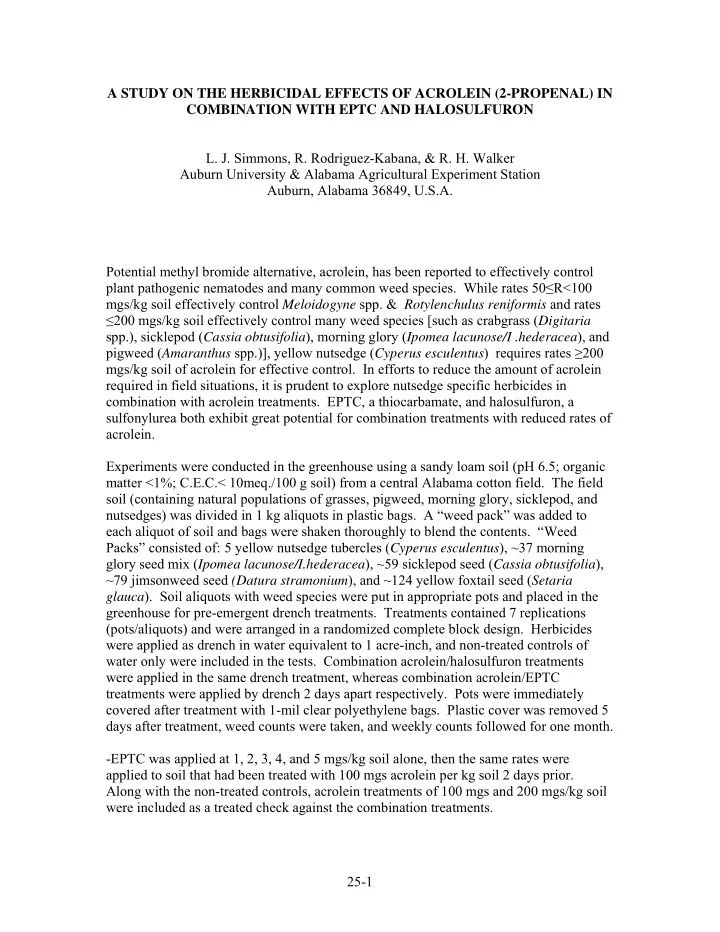

A STUDY ON THE HERBICIDAL EFFECTS OF ACROLEIN (2-PROPENAL) IN COMBINATION WITH EPTC AND HALOSULFURON L. J. Simmons, R. Rodriguez-Kabana, & R. H. Walker Auburn University & Alabama Agricultural Experiment Station Auburn, Alabama 36849, U.S.A. Potential methyl bromide alternative, acrolein, has been reported to effectively control plant pathogenic nematodes and many common weed species. While rates 50 ≤ R<100 mgs/kg soil effectively control Meloidogyne spp. & Rotylenchulus reniformis and rates ≤ 200 mgs/kg soil effectively control many weed species [such as crabgrass ( Digitaria spp.), sicklepod ( Cassia obtusifolia ), morning glory ( Ipomea lacunose/I .hederacea ), and pigweed ( Amaranthus spp.)], yellow nutsedge ( Cyperus esculentus ) requires rates ≥ 200 mgs/kg soil of acrolein for effective control. In efforts to reduce the amount of acrolein required in field situations, it is prudent to explore nutsedge specific herbicides in combination with acrolein treatments. EPTC, a thiocarbamate, and halosulfuron, a sulfonylurea both exhibit great potential for combination treatments with reduced rates of acrolein. Experiments were conducted in the greenhouse using a sandy loam soil (pH 6.5; organic matter <1%; C.E.C.< 10meq./100 g soil) from a central Alabama cotton field. The field soil (containing natural populations of grasses, pigweed, morning glory, sicklepod, and nutsedges) was divided in 1 kg aliquots in plastic bags. A “weed pack” was added to each aliquot of soil and bags were shaken thoroughly to blend the contents. “Weed Packs” consisted of: 5 yellow nutsedge tubercles ( Cyperus esculentus ), ~37 morning glory seed mix ( Ipomea lacunose/I.hederacea ), ~59 sicklepod seed ( Cassia obtusifolia ), ~79 jimsonweed seed (Datura stramonium ), and ~124 yellow foxtail seed ( Setaria glauca ). Soil aliquots with weed species were put in appropriate pots and placed in the greenhouse for pre-emergent drench treatments. Treatments contained 7 replications (pots/aliquots) and were arranged in a randomized complete block design. Herbicides were applied as drench in water equivalent to 1 acre-inch, and non-treated controls of water only were included in the tests. Combination acrolein/halosulfuron treatments were applied in the same drench treatment, whereas combination acrolein/EPTC treatments were applied by drench 2 days apart respectively. Pots were immediately covered after treatment with 1-mil clear polyethylene bags. Plastic cover was removed 5 days after treatment, weed counts were taken, and weekly counts followed for one month. -EPTC was applied at 1, 2, 3, 4, and 5 mgs/kg soil alone, then the same rates were applied to soil that had been treated with 100 mgs acrolein per kg soil 2 days prior. Along with the non-treated controls, acrolein treatments of 100 mgs and 200 mgs/kg soil were included as a treated check against the combination treatments. 25-1
-Halosulfuron was applied at 0.01, 0.025, 0.05, 0.075, and 0.1 mgs/kg soil alone, and the same rates were applied as a combination drench with 100 mgs/kg acrolein. Along with the non-treated controls, acrolein treatments of 100 mgs and 200 mgs/kg soil were included as a treated check against the combination treatments. -Acrolein/EPTC- Figure 1. Nutsedge populations were zero for all combination treatments 26 days after application except the lowest rate of EPTC (1 mgs/kg soil EPTC used in combination with 100 mgs/kg soil acrolein) resulting in an average of 0.9 nutsedge plants per pot. While nutsedge numbers were low in the EPTC treatment alone, effective control was not obtained for morning glory, jimsonweed, crabgrass, and sicklepod species at any rate of EPTC used. Acrolein at 100mgs/kg did not control of yellow nutsedge. -Acrolein/halosulfuron- Figure 2. All treatments of halosulfuron in combination with acrolein effectively controlled yellow nutsedge, and all combination treatments except the lowest (0.01 mgs/kg soil) rate of halosulfuron with 100 mgs acrolein reduced nutsedge populations to zero. Halosulfuron treatments alone effectively controlled yellow nutsedge, however, all rates applied did not provide adequate control of any other weed species used. Acrolein alone at 100mgs/kg soil provided no control of nutsedge as compared to the non-treated pots, and acrolein at 200 mgs/kg soil only reduced population numbers. Data from these experiments show that for effective herbicidal control, rates of drench- applied acrolein can be significantly reduced if applied in combination with either EPTC or halosulfuron. 25-2
Total Weeds after 26 days EPTC Weeds per pot FLSD (p0.05) =3.42 25 EPTC + 20 acrolein 15 100mgs 10 acrolein 5 100mgs 0 acrolein 0 1 2 3 4 5 200mgs mgs EPTC/ kg soil Yellow nutsedge EPTC after 26 days YNS per pot FLSD (p0.05) =1.61 6 EPTC + acrolein 4 100mgs acrolein 2 100mgs 0 acrolein 0 1 2 3 4 5 200mgs mgs EPTC/ kg soil Weeds other than YSN EPTC after 26 days Weeds per pot FLSD (p0.05) =3.42 20 EPTC + 15 acrolein 100mgs 10 acrolein 5 100mgs 0 acrolein 0 1 2 3 4 5 200mgs mgs EPTC/ kg soil Figure 1. Herbicidal activity of EPTC and acrolein combination drench treatments on sandy loam cotton field soil with yellow nutsedge, morning glory, jimsonweed, foxtail, and sicklepod weed seeds added. Rates of acrolein required for effective weed control successfully reduced. 25-3
Total Weeds after 26 days halosulfuron Weeds per pot FLSD (p0.05) =4.57 40 halosulfuron 30 + acrolein 100mgs 20 acrolein 10 100mgs 0 acrolein 0 0.01 0.03 0.05 0.08 0.1 200mgs mgs halosulfuron/ kg soil Yellow nutsedge halosulfuron after 26 days YNS per pot FLSD (p0.05) =1.86 6 halosulfuron + acrolein 4 100mgs acrolein 2 100mgs 0 acrolein 0 0.01 0.03 0.05 0.08 0.1 200mgs mgs halosulfuron/ kg soil Weeds other than YSN halosulfuron after 26 days YNS per pot FLSD (p0.05) =4.57 30 halosulfuron + acrolein 20 100mgs acrolein 10 100mgs 0 acrolein 0 0.01 0.03 0.05 0.08 0.1 200mgs mgs halosulfuron/ kg soil Figure 2. Herbicidal activity of halosulfuron and acrolein combination drench treatments on sandy loam cotton field soil with yellow nutsedge, morning glory, jimsonweed, foxtail, and sicklepod weed seeds added. Rates of acrolein required for effective weed control successfully reduced. 25-4
Recommend
More recommend